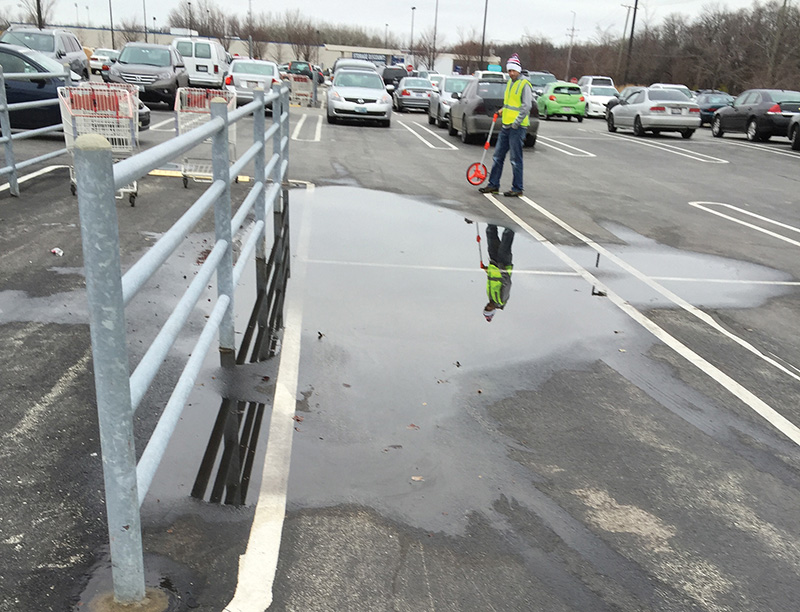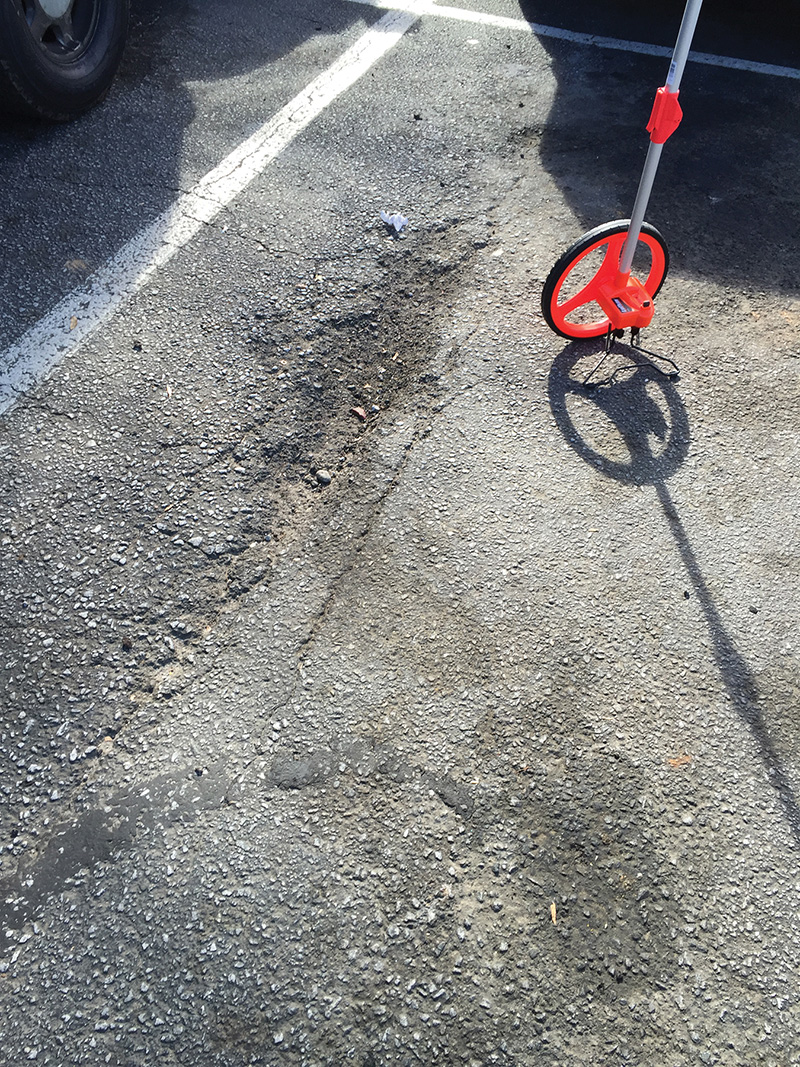Cover your assets with pavement assessments.
By Michael Zator
You’ve probably heard the old adage ‘no news is good news.’ As a former property manager, I know that phrase equates to a successful day on the job. After all, customers, tenants, employees and stakeholders tend to quickly mention negative conditions of a property, but remain quiet if all appears well, as that is the expectation. Indeed, keeping properties maintained and continually operating is an endless endeavor. And, in today’s economic environment, it is also increasingly difficult to maintain an aging portfolio in an efficient way.
From reduced resources and diminished budgets to limited visibility, property managers must implement cost-effective solutions without compromising the integrity of their properties. Retail and restaurant properties, in particular, often have a brand standard to uphold which, at its core, aims to deliver a consistent customer experience from site-to-site. Just one section of a property failing to meet the standard could impact the overall brand image. One of the largest areas, and oftentimes the most overlooked, is the parking lot. While it’s true that customers do not conduct business on the pavement, their experience starts the moment they drive onto the property and step foot on your parking lot.
 However, since most of the focus is on the interior (where the transactions occur), exterior maintenance may be deferred until there is a widespread problem or liability. Unfortunately, when this occurs, issues may be too costly to repair.
However, since most of the focus is on the interior (where the transactions occur), exterior maintenance may be deferred until there is a widespread problem or liability. Unfortunately, when this occurs, issues may be too costly to repair.
The toughest challenge with pavement maintenance is that most property managers cannot visit every site in their portfolio; therefore, they do not know the condition of their pavement assets. Not knowing what is out there makes it difficult to budget for or make informed decisions concerning how best to utilize and optimize existing funds. The result is that property managers may spend more on unnecessary repairs or wait too long to perform maintenance, leading to more costly, structural remedies. A pot hole, for example, can cost upwards of $6 to $8 per square foot (equivalent to $0.20 to $0.40 per square foot per year to repair over the course of 10 years). Performing preventative maintenance with the right repair at the right time (prior to pothole formation) can save $0.10 to $0.30 per square foot per year over 10 years. But, to determine preventative procedures as part of a proactive strategy requires routine pavement assessments.
What is a Pavement Assessment?
Pavements are aging, but budgets are not growing. Pavement assessments are reports that help property managers, especially those working in a decentralized facilities department, implement proactive strategies for pavement maintenance, which saves time, money and extends pavement usability.
A best-in-class pavement assessment starts with a visual inspection to document the overall condition of the pavement such as surface distress, ride quality and aesthetics. The data collected will help identify repair and replacement needs, prioritize repairs on a site or set of sites, and create budgets for planning up to 5 years ahead.
Pavement assessments should not be difficult to interpret. No one wants to receive a report that has too much technical jargon. The company performing the assessments should be able to provide you with examples of their reports and, from there, you should be able to ask for any unique data specific to your sites. Ultimately, assessments should be simple to follow and understand, and made actionable to execute your plan.
Key Components of Pavement Assessments
All pavement assessments need to follow a rating system to explain the relative condition or quality of pavement assets in your portfolio. This allows the property manager to get a quick view of the condition of their properties and helps them summarize the findings to their superiors and stakeholders. A widely used system is the Pavement Condition Index (or PCI). The PCI was developed by the U.S. Army Corps of Engineers and adopted by ASTM (American Society for Testing and Materials). It is a numerical indicator that rates the condition of pavement. The system provides many benefits such as a quick view of pavement condition, which translates across the industry; future maintenance needs; and the ability to monitor and statistically track condition over time.
 Once properties are assigned a rating, they can be ranked or prioritized according to condition and repair needs. Next, budgets can be created based on timing of maintenance and the cost of procedures. In fact, one of the main components of a basic assessment is a capital expenditure plan, based on standard degradation over time and current conditions. This plan helps property managers better manage schedules and spending from month to month.
Once properties are assigned a rating, they can be ranked or prioritized according to condition and repair needs. Next, budgets can be created based on timing of maintenance and the cost of procedures. In fact, one of the main components of a basic assessment is a capital expenditure plan, based on standard degradation over time and current conditions. This plan helps property managers better manage schedules and spending from month to month.
Advanced assessments provide more detail to help impact decision-making in both the long and short term. Advanced reports should come with detailed scopes of work covering recommendations and budget projections for the next 5 years as well as repair maps including photos of damaged areas. The scope of work document covering recommendations for the first year can be sent directly to contractors so that all bids can be compared on an apples-to-apples basis.
It is recommended to perform pavement assessments every 2 to 4 years, depending on the condition of the property. Properties that have been recently repaved and/or are following preventative maintenance practices may be able to go a little longer in between assessments; however, sites in average to poor condition may need to be refreshed sooner. In either case, developing a cadence for performing assessments allows you to keep the data fresh and update budgets accordingly. It also provides data points to see how much the property has degraded since the last assessment.
Partnering with a Vendor
There are many service providers that will gladly assess your properties and then perform the paving or pavement maintenance procedures. But, in going that route, you are putting the control and your budget in their hands. Instead, look for a provider that specializes in pavement assessments. This ensures your interests are the main focus and there are no conflicts of interest. The result is always an objective recommendation and effective outcome for you to confidently plan, bid and execute the work. The company that performs the assessment may also be able to help you specify and procure materials or prepare bids and select a contractor.
Prior to selecting a vendor, find out what differentiates them and ask to see a sample report and request references. Reach out to their satisfied clients and question them about the accuracy or long term benefits of the assessment. Carefully review different assessment plans or tiers offered by all vendors. Plans may range from basic, covering only a few sites, to advanced, covering an entire portfolio, and some providers may even offer recommendations for future enhancements. Be sure to stress your goals and exactly what you are looking to achieve with your assessment so that you can accurately compare services and pricing models from multiple vendors.
Know Your Pavement
The most fundamental way to optimize your pavement maintenance budget is by assessing the condition of pavement in your portfolio. Pavement assessments compile the most powerful information pertaining to your parking lots in one easy-to-read report. If you don’t know what is out there, now is the time to find out! After all, your pavement can steer business to your door or drive it away.
— A former property manager, Michael Zator currently leads the Partner Solutions arm of Let’s Pave as vice president of pavement management services. He has over 20 years of retail experience with concentration in corporate finance and facilities management. Zator leverages this expertise to provide customers with pavement management services tailored to supplement and enhance their current pavement program.
